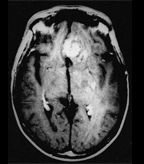Enzyme Linked to Most Common Brain Tumor
Higher levels of the enzyme kallikrein 6 (KLK6) are associated with glioblastoma multiforme, the most common type of brain tumor, according to a new study from researchers at the Mayo Clinic.
Higher levels of the enzyme kallikrein 6 (KLK6) are associated with glioblastoma multiforme, the most common type of brain tumor, according to a new study. Researchers at the neurobiology of disease program at the Mayo Clinic in Rochester, Minnesota and colleagues studied expression levels of KLK6 in 60 grade IV glioblastoma tumor samples and in less aggressive grade III tumors.

Recurrent glioblastomas produce expansile foci of contrast enhancement. These imaging features are nonspecific, however, and may be due to radionecrosis rather than recurrent tumor.
Patients whose tumors had higher levels of KLK6 had a poorer prognosis after adjusting for factors such as gender and performance score. KLK6 was found to promote tumor cell survival. The study is published in Neuro-Oncology.
In glioblastoma cell line experiments, the presence of KLK6 reduced the sensitivity of the cells to cytotoxic agents, including cisplatin, as well as radiotherapy and temozolomide, the current standard of care for glioblastoma. The in vitro research suggests that KLK6 can promote resistance to programmed cell death, or apoptosis. Adding KLK6 to glioblastoma cells in vitro promoted resistance to both chemotherapy and radiotherapy.
Glioblastoma multiforme is an aggressive and invasive tumor. Although there have been advances in surgical techniques, as well as advances in chemotherapy and radiotherapy approaches, the cancer remains difficult to treat. The median survival is only 15 months.
According to the study researchers, these results provide a new way to target glioblastoma. When the KLK6 receptor was blocked on tumor cells, the cells became more sensitive to cytotoxic drugs.
Grade IV glioblastoma tumors had the highest levels of KLK6 compared with grade III tumors. In patients, higher levels of KLK6 correlated with shorter survival-those patients with the highest levels of the enzyme lived for 276 days compared with 408 days in patients with lower levels. “This suggests that the level of KLK6 in the tumor provides a prognosticator of patient survival,” senior author Isobel Scarisbrick, PhD, of the Mayo Clinic’s department of physical medicine and rehabilitation, said in a press release.
The researchers also used a tissue culture model of glioblastoma to demonstrate that the cells become both chemotherapy and radiation resistant when the KLK6 enzyme was added to the culture. “Our results show that KLK6 functions like a hormone, activating a signaling cascade within the cell that promotes tumor cell survival,” said Scarisbrick. “The higher the level of the enzyme, the more resistant the tumors are to conventional therapies.”